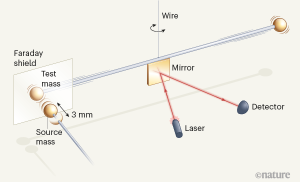Blog
A Weakly Pull
11 March 2021
Between any two masses, there is a gravitational pull of mutual attraction. It doesn’t matter if they are planets, cannonballs, or even apples. Thus says Newton’s Universal Law of Gravity. Newton didn’t discover this law while sitting under an apple tree. He didn’t even discover it entirely on his own. But the law bears Newton’s name because he more than anyone else changed the way we looked at gravity.
Through his laws of motion, Newton demonstrated that the forces two masses exert upon each other follow a simple relationship known as the inverse square law. If you halve the distance between two masses, their force of attraction will increase by a factor of four. It is a theory so simple you can test it using a cable and a few masses.
Even after three centuries, Newton’s gravity is one of the most basic laws of physics. It is so accurate we have used it to send humans to the Moon and land rovers on Mars. But we also know that Newton’s gravitational model has its limits. For example, for strong gravitational fields, it is supplanted by general relativity. It should also be supplanted by a theory of quantum gravity at small distances and with tiny masses. On those scales, we know that quantum theory applies, and Newton’s gravity is a classical theory.
But we don’t have a theory of quantum gravity, and gravity is such a small force it’s nearly impossible to measure at quantum scales. But we’re getting close.

Several experiments have been done to test the limits of Newtonian gravity. For example, there have been studies testing whether it applies at short distances. There have even been studies to see if the inverse square relation breaks down on small scales, which could be evidence of higher spatial dimensions. But this latest study specifically looks at small masses.1
Most of the experiments testing Newton’s gravitational law have involved bodies with masses of kilograms, or at least grams. This new study looks at the force between gold spheres with masses less than 100 milligrams. Gravitational forces are so small at this scale they can be overwhelmed by even the slightest disturbance. The weight of a red blood cell in Earth’s gravity is three times larger than the gravitational force between the gold spheres.
To filter out any outside noise, the team shielded the spheres from any electrical influence. They also wobbled one of the masses so that the gravitational force would oscillate with a regular period. This allowed them to distinguish the gravitational force from any random noise.
The experiment confirmed Newtonian gravity, but this isn’t surprising. Even milligram masses are expected to behave classically. What makes this experiment exciting is that it shows how we might test even smaller masses. The team suggests future experiments should be able to test masses on the order of micrograms. This is the scale of the Planck mass, where quantum effects should kick in.
Westphal, T., Hepach, H., Pfaff, J. & Aspelmeyer, M. “Measurement of Gravitational Coupling between Millimeter-Sized Masses.” Nature 591 (2021): 225–228. ↩︎